Impressed Current Cathodic Protection systems require the use of a power supply to drive current. And, for most applications this is going to be a Transformer based AC/DC Power Supply. In the CP world this is commonly referred to as a cathodic protection rectifier.
The good news is that today’s cathodic protection rectifiers are reliable with a very long service life.
But… this does not mean that all rectifiers are the same – some rectifiers are simply made better.
There are a lot of little things, none of which are particularly costly, but when all added up create a higher quality, safer, and better product. Why settle for a good product when you can get a great product?
Let’s take a deeper dive.
Here are 6 things to look for if you want the best cathodic protection rectifier for your application:
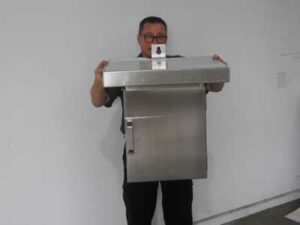
What makes the best cathodic protection rectifier? Johnny C. demonstrates how light the marine grade aluminum enclosure is—35 lbs. vs 90 lbs. for a similar steel enclosure.
1. Marine Grade Aluminum Case
The choice of enclosure type is one of those little items, and at JA Electronics that choice is clear to us. We standardize on marine grade aluminum enclosures because compared to steel, they:
- Offer better corrosion resistance than galvanized steel
- Are 250% lighter than steel
- Have better thermal conductivity
- Are not subject to warping during the hot dipped galvanizing process
This means a lighter rectifier, and a case that will not corrode, is less prone to overheating, and does not suffer from poorly fitting doors with gaps to allow ingress for insects and critters to use the enclosure for nesting.
2. Color Coded, Engraved for Life
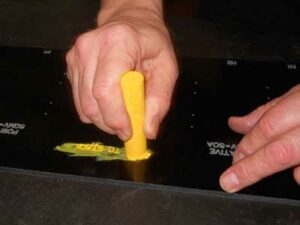
Bold and easy to read rectifier panels.
One of the great “little” detail things that doesn’t really have a significant impact on the cost of the rectifier is the use of color-coded engraving and wiring.
Color coding of the wiring and the use of permanent engraved markings provides for an easier identification of components and wiring assemblies in the field. This simple enhancement is not just for good looks—although it does look good!
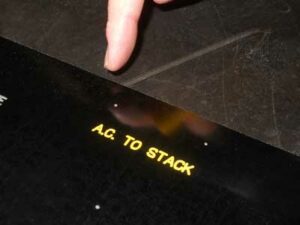
Engraved color coding lasts for the life of the rectifier.
With any electrical device, it is an important safety feature that the cabling/wiring is easily identifiable to the technician in the field tasked with maintaining the unit. Mis-identifying electrical wires can be a safety issue.
Labels or semi-permanent stickers or decals will fade over time and may even fall off the unit.
Permanent engraving with coordinated color coding will last the life of the unit.
3. Finishing Details for Ease of Use and Long Life
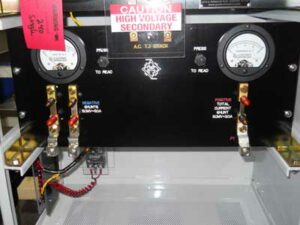
Completed cathodic protection rectifier rack assembly.
The photo below shows a completed rack assembly. The unit is clean, neat, and thoughtfully laid out for ease of access… the real quality comes with all the little things that may not immediately jump out at you, but for the technicians in the field these little things will last a long time.
For the shunts on the front panel, we can provide color-coded 5-way binding posts that greatly improve the safety involved in taking shunt measurements while helping the technician to use the proper polarity wires from their meter.
This unit utilizes stainless steel hardware and zinc plated rack assemblies for corrosion resistance so that the panel interior does not begin to oxidize or deteriorate in harsh outdoor environments.
4. Left Side Door Maintenance to Simplify Access
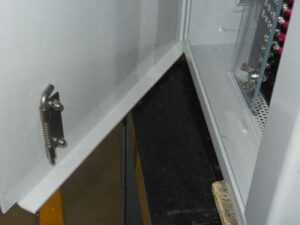
JA rectifiers feature a spring loaded stainless steel latch assembly.
Typical cathodic protection rectifiers are designed with two side maintenance access doors (left and right), in addition to the front operations access door.
JA Electronics has standardized on a single left door maintenance access. We accomplish this by designing the power chassis with left side maintenance access as a key consideration. All components that require replacement or access for troubleshooting can be easily accessed from the left side door.
This design feature eliminates the need for a right-side door making for a cleaner/sturdier unit with fewer pieces of hardware. Our left side maintenance access door can be secured with a spring-loaded stainless-steel latch assembly to assure that the door does not swing open accidentally.
5. Modular Bridge Diode Assembly Makes Troubleshooting a Breeze
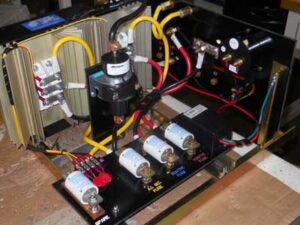
Easy to troubleshoot design.
JA Electronics uses a modular bridge diode assembly that is easy to trouble shoot and replaces in minutes. The large Alodine® aluminum heat sinks are electrically isolated and finned for efficient heat dissipation. The key power components are conservatively designed with a 20% overdesign in both the bridge & transformer.
6. Brass Solder Lugs for Superior Reliability
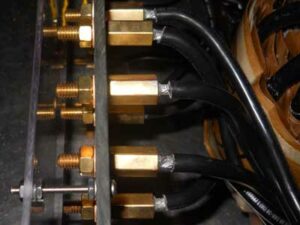
Superior welded connections.
The lug assemblies on the fine and course tap settings for JA Electronics rectifiers are custom brass soldered assemblies. The less reliable, although still quite common, method to make the lug connections involve a bolt, a nut, and a ring terminal. These mechanical connections are inferior to a welded connection and can turn or spin and in worst case can short out to an adjacent lug. Our process for fabricating the brass solder lugs is a significant upgrade in quality.
